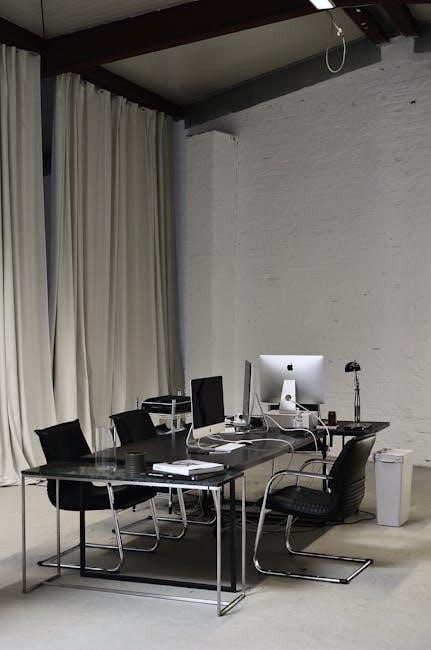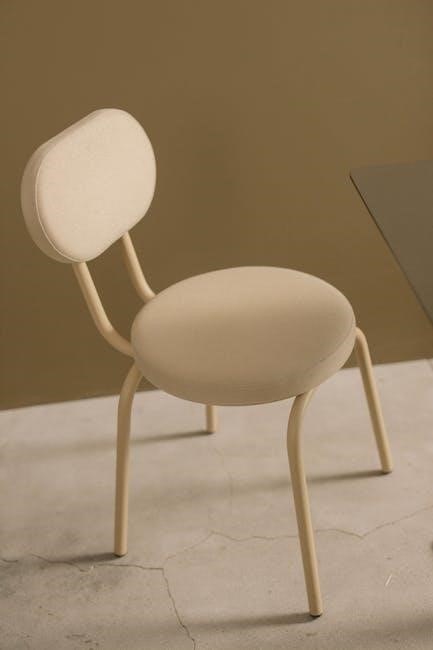Properly adjusting your office chair is crucial for maintaining good posture, reducing discomfort, and enhancing productivity. This guide will walk you through essential adjustments to optimize your chair for comfort and ergonomics, ensuring a healthier work experience.

How to Adjust Your Office Chair
Adjusting your office chair involves customizing its features to fit your body. Start by setting the seat height so your feet are flat and knees are at 90 degrees. Use the lever under the seat to raise or lower it while seated. Next, adjust the backrest to support your lower back, ensuring it aligns with your spine’s natural curve. Modify the tilt by using the appropriate lever or knob to recline comfortably while maintaining support. Adjust the armrests to a height where your elbows are at 90 degrees, keeping your arms relaxed. Finally, ensure the seat depth allows a couple of inches between the seat edge and the back of your knees. Make gradual adjustments, testing each for comfort, and refer to your chair’s manual or online guides for specific instructions. Regular adjustments will help maintain proper posture and comfort throughout the day.
Seat Height Adjustment for Proper Posture
Adjusting the seat height of your office chair is essential for maintaining proper posture and comfort. Begin by sitting in the chair and using the adjustment lever to raise or lower the seat until your feet are flat on the floor. Ensure your knees are at a 90-degree angle, with your thighs parallel to the floor or slightly sloping downward. This position supports good blood flow and prevents pressure on the back of your legs. For shorter individuals, a footrest may be necessary if the chair doesn’t lower sufficiently. Proper seat height helps avoid back pain and circulatory issues, promoting overall well-being. Adjust the height while seated to ensure accuracy and comfort, and consider referring to your chair’s manual for specific instructions.

Backrest and Lumbar Support Alignment
Properly aligning the backrest and lumbar support of your office chair is vital for maintaining a healthy spine and preventing back strain. Begin by adjusting the backrest height so it fits snugly against your upper and middle back, ensuring natural spinal alignment. The lumbar support should be positioned to match the curve of your lower back, providing firm yet comfortable pressure. For taller individuals, some chairs allow adjusting the backrest height to accommodate longer torsos. Once aligned, test the position by sitting upright without leaning forward or backward excessively. This setup promotes good posture and reduces the risk of back pain during long work hours.
Armrest Positioning for Comfort
Correctly positioning the armrests of your office chair is essential for maintaining comfort and preventing strain on your shoulders and wrists. Adjust the armrest height so your elbows are at a 90-degree angle, with your forearms parallel to the desk. Ensure the armrests are low enough to allow your shoulders to relax downward, avoiding any upward tension. The armrests should also be positioned to support your arms without interfering with your desk or workflow. If your chair allows, adjust the width of the armrests to fit your body, ensuring they don’t press into your sides. Proper armrest alignment helps reduce fatigue and promotes a neutral hand and wrist position during typing or other tasks.

Features of an Ergonomic Office Chair
An ergonomic office chair includes adjustable features like seat height, lumbar support, and armrests, ensuring proper posture and comfort. Breathable fabrics and durable casters enhance usability and mobility.
Casters and Mobility

Casters are essential for smooth mobility in an office chair, allowing easy movement around the workspace. High-quality casters are designed to glide effortlessly on various floor surfaces, reducing friction and noise. For enhanced stability, many chairs feature a caster lock mechanism, which prevents unintended movement when reclining or leaning. This feature is particularly useful for maintaining balance during tasks that require reaching or stretching.
Heavy-duty casters are ideal for robust office environments, while smaller, softer casters are better suited for delicate flooring. The 360-degree swivel function enables seamless rotation, making it easier to access different areas of the desk or engage in collaborative work. Properly functioning casters contribute to a more dynamic and efficient work experience, ensuring comfort and convenience throughout the day.
Breathable Fabric and Ventilation
Breathable fabric and proper ventilation are critical features of an ergonomic office chair, ensuring comfort during long working hours. Chairs with mesh or perforated fabric allow air to circulate, preventing heat buildup and moisture accumulation. This helps regulate body temperature and reduces discomfort caused by prolonged sitting. Additionally, some chairs feature ventilation systems or cooling designs that enhance airflow, keeping you fresh and comfortable throughout the day. Prioritizing breathable materials can significantly improve your overall seating experience, making it easier to focus and stay productive without distractions from discomfort or sweat. Proper ventilation also extends the chair’s durability by preventing moisture-related damage to the fabric or cushions. Choose a chair that balances aesthetics with functional breathability for optimal comfort and health benefits.

Maintenance and Upkeep
Regular cleaning with mild detergents and lubricating moving parts ensures smooth functionality and extends the chair’s lifespan. Proper maintenance prevents damage and maintains optimal performance and appearance.
Cleaning the Chair
Regular cleaning is essential for maintaining the hygiene and longevity of your office chair. Use mild detergents and soft cloths to wipe down the seat, backrest, and armrests. Avoid harsh chemicals as they may damage the fabric or finishes. For leather chairs, apply a conditioner to prevent cracking. Fabric chairs can be vacuumed to remove dust and debris. Pay attention to crevices where dust often accumulates. Metal and plastic parts should be cleaned with a damp cloth. Cleaning not only keeps your chair looking new but also ensures a fresh, comfortable workspace. Consistency in cleaning prevents the buildup of dirt and germs, promoting a healthier environment.
Lubricating Moving Parts
Lubricating the moving parts of your office chair is vital for smooth operation and longevity. Regularly apply silicone-based spray to the casters, tilt mechanisms, and any other movable joints. Avoid using oil-based products, as they may attract dust and dirt. Before lubricating, wipe down the parts to remove dirt or debris. Spray lightly and wipe off any excess to prevent residue buildup. Lubricate every 6-12 months or when you notice squeaking or stiffness. Proper lubrication ensures the chair moves effortlessly, reducing wear and tear. This maintenance step keeps your chair functioning optimally and extends its lifespan. Regular checks and lubrication are simple yet effective ways to maintain your office chair’s performance and comfort.

Troubleshooting Common Issues

Identify and resolve common issues like stuck adjustments or wobbling. Check mechanisms for obstructions, tighten loose parts, and lubricate moving components to restore smooth functionality and stability.
Addressing a Stuck Height Adjustment
If your office chair’s height adjustment is stuck, start by inspecting the mechanism for dust or debris. Clean the area thoroughly with a soft brush or compressed air. Lubricate the moving parts using silicone spray or oil to reduce friction. Gently rock the chair while adjusting the height to loosen any stubborn components. If the issue persists, consider disassembling the height adjustment mechanism to check for worn or damaged parts. Replace any faulty pieces and reassemble carefully. Regular maintenance, such as periodic lubrication, can prevent future malfunctions and ensure smooth operation.
Fixing a Wobbly Base
A wobbly office chair base can be destabilizing and distracting. Begin by inspecting the casters or wheels for obstructions like debris or uneven flooring. Clean or replace damaged casters to ensure smooth movement. Tighten all bolts and screws on the base and gas lift mechanism, as loose components often cause instability. If the issue persists, check for worn-out or damaged parts, such as the gas cylinder or base plate, and replace them if necessary. Using felt pads or adjusting the chair on a level surface can also stabilize the base. Regularly maintaining and inspecting the chair’s foundation will help prevent wobbling and ensure long-term stability and safety.

Health Benefits of Proper Adjustment
Properly adjusting your office chair offers numerous health benefits, particularly for those who spend long hours sitting. Correct seat height and lumbar support promote good posture, reducing strain on the spine and lowering the risk of back pain. Adjusting the chair height ensures your feet are flat on the floor, improving blood circulation and preventing swelling in the legs. Armrests set at the right height relieve shoulder tension, while a well-positioned backrest supports the natural curve of the spine, minimizing the risk of long-term musculoskeletal issues. By optimizing your chair settings, you can enhance comfort, reduce fatigue, and create a healthier working environment that supports overall well-being and productivity.
Properly adjusting your office chair is essential for ensuring comfort, promoting good posture, and maintaining overall well-being. By following the guidelines outlined in this guide, you can optimize your chair to support your body, reduce the risk of discomfort, and enhance productivity. Regularly assessing and adjusting your chair settings can make a significant difference in your long-term health and work experience. Remember, a well-adjusted office chair is not just a piece of furniture—it’s a key component of a healthy and efficient workspace. Take the time to fine-tune your chair today and enjoy the benefits of a more comfortable and ergonomic work environment tomorrow.
